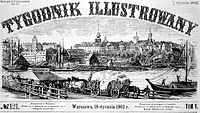 Tygodnik Illustrowany no. 121 (1862) Tygodnik Illustrowany no. 121 (1862) | |
| Type | weekly magazine |
|---|---|
| Founder(s) | Józef Unger |
| Publisher | Gebethner i Wolff |
| Language | Polish language |
Tygodnik Illustrowany (Polish: [tɨˈɡɔdɲik ilustrɔˈvanɨ], The Illustrated Weekly) was a Polish language weekly magazine published in Warsaw from 1859 to 1939. The magazine focus was on literary, artistic and social issues.
History
It is said to have been one of the most important and popular Polish magazines of the period, profitable and widely respected. It was particularly popular among the inteligencja social group. It was the oldest cultural periodical published in Warsaw.
The magazine was first published by Józef Unger; later it was taken over by the company Gebether i Wolff. Editors included: Ludwik Jenike, Józef Wolff, Artur Oppman, Adam Grzymała-Siedlecki, Zdzisław Dębicki, Piotr Choynowski, W. Gebethner, Jan Robert Gebethner, W. Czarski and C. Staszewicz. In 1909 its circulation was reported to be about 20,000.
The magazine commonly published articles on history of Poland and Polish society, including archeological, ethnographic and similar essays. It also published texts on the progress of technology and on voyages and explorations. It serialized some novels, including Eliza Orzeszkowa's Nad Niemnem, Władysław Reymont's Chłopi Stefan Żeromski's Popioły. Texts published in it are still seen as high quality.
The magazine history ends with the German invasion of Poland in September 1939; the last issue was published on 3 September that year.
Among its contributors most prominent were Polish literary figures such as Józef Ignacy Kraszewski, Eliza Orzeszkowa, Bolesław Prus and Nobel Prize winner Henryk Sienkiewicz. Others included: Tadeusz Boy-Żeleński, Władysław Skoczylas, Władysław Sabowski, Jan Zachariasiewicz, Zygmunt Miłkowski, P. Chmielewski, Wojciech Bogusławski, Marian Gawalewicz, Józef Wieniawski.
It is credited with popularizing woodcut illustrations in Poland, publishing works by artists such as Wojciech Gerson, Henryk Pillati, Franciszek Kostrzewski and Juliusz Kossak.
References
- ^ HALINA LERSKI (30 January 1996). Historical Dictionary of Poland, 966-1945. ABC-CLIO. pp. 615–616. ISBN 978-0-313-03456-5. Retrieved 23 May 2013.
- Anna Agnieszka Szablowska; Мар'яна Сеньків; Музей етнографії та художнього промислу Інституту народознавства НАН України (2009). Plakat polski: ze zbiorów Muzeum Etnografii i Przemysłu Artystycznego Instytutu Narodoznawstwa Narodowej Akademii Nauk Ukrainy we Lwowie. Ministerstwo Kultury i Dziedzictwa Narodowego. p. 72. ISBN 978-83-929227-1-1. Retrieved 23 May 2013.
- ^ "Opis realizacji projektu". Bilp.uw.edu.pl. Retrieved 2014-04-04.
- ^ Alina Brodzka (1992). Słownik literatury polskiej XX wieku. Ossolineum. p. 1339. ISBN 978-83-04-03942-1. Retrieved 23 May 2013.
- ^ "Encyklopedie w INTERIA.PL - największa w Polsce encyklopedia internetowa". Encyklopedia.interia.pl. Retrieved 2014-04-04.
- Stanisław Bylina (1978). Stosunki literackie polsko-czeskie i polsko-słowackie, 1890-1939: praca. Zakład Narodowy im. Ossolińskich. p. 98. Retrieved 23 May 2013.
- ^ "Tygodnik Illustrowany - Przyjaciel Ludu - WIEM, darmowa encyklopedia". Portalwiedzy.onet.pl. Retrieved 2014-04-04.
- Alina Brodzka (1992). Słownik literatury polskiej XX wieku. Ossolineum. p. 130. ISBN 978-83-04-03942-1. Retrieved 23 May 2013.
External links
Categories:- 1859 establishments in Poland
- 1939 disestablishments in Poland
- Defunct magazines published in Poland
- Defunct literary magazines published in Europe
- Magazines established in 1859
- Magazines disestablished in 1939
- Magazines published in Warsaw
- Visual arts magazines published in Poland
- Polish-language magazines
- Weekly magazines published in Poland